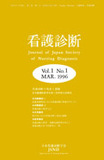Japanese
English
- 有料閲覧
- Abstract 文献概要
- 参考文献 Reference
1950年代当時から始まった米国における看護診断発達史と,その発達にきわめて強力に影響を受けて今日に至っている我が国の看護診断史を比較検討した.その結果,我が国は約10年の遅れで米国と同様な道をたどっているようである.現在は,米国は診断・介入・成果に至る一連の看護業務分類を指向しているが,他方,我が国はNANDA(北米看護診断協会)の診断名を導入した臨床での実践期に入っているといえる.しかし,教育や研究はまだ手つかずの状態である.そのうえで,臨床,教育,研究の3側面から課題を提出した.その中で特に重点だけを挙げるならば,臨床ではアセスメントの強化と診断概念の理解,診断を実践に生かす,サポート源となる人材の確保と活用を,教育ではアセスメント技術と批判的思考の強化,診断概念を教授内容に計画的に組み入れること,研究では診断妥当性の研究,我が国の診断・介入・成果に至る看護業務分類の開発などの課題を提出した.
In the United States, nursing diagnosis had been advocated since 1950's. As a conclusion compared with Japanese and American history of nursing diagnosis, Japan is now going the same way as the U.S. behind about 10 years. Now the U.S. is orienting to the classification of nursing practice including diagnosis, intervention and outcome, the other hand, Japan is in the age of nursing diagnosis clinically using NANDA labels. Japanese Society of Nursing Diagnosis was just founded in 1995, but the education and reseach are future tasks. Our future tasks were discussed in practice, education, and research. Clinically nurse's tasks are to understand diagnostic concepts, reinforce critical thinking, and maintain and use support sources. In education, those are to train extended assesment skills and critical thinking, teach diagnostic concepts. The research is urgent and the tasks are to study accuracy and validation of diagnosis, develop Japanese nursing classification of nursing practice.
Copyright © 1996, Japan Society of Nursing Diagnosis. All rights reserved.


